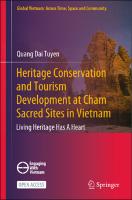Heritage Conservation and Tourism Development at Cham Sacred Sites in Vietnam
Living Heritage Has A Heart
| dc.contributor.author | Tuyen, Quang Dai | |
| dc.date.accessioned | 2023-11-13T16:42:41Z | |
| dc.date.available | 2023-11-13T16:42:41Z | |
| dc.date.issued | 2023 | |
| dc.identifier | ONIX_20231113_9789819933501_40 | |
| dc.identifier | OCN: 1404837423 | |
| dc.identifier.uri | https://library.oapen.org/handle/20.500.12657/85095 | |
| dc.description.abstract | This open access book considers the growing field of heritage tourism from community perspectives. It explores how the Cham—Vietnam’s large ethnic minority—reconcile their needs for economic development with the boundaries circumscribed by their traditional culture. It examines struggles that local minority stakeholders like the Cham face when trying to participate in areas of development that typically fall under State control. How will tourism affect the ancient sacred spaces that are the Cham’s lifeblood? In what areas is their participation permitted? From what areas are they excluded? Through a novel mix of indigenous methods, participant observation, local voices, and rich ethnographic description, this book provides a rare glimpse into the discourses that have been percolating throughout the community in recent years. The relevance of this study extends beyond the Cham community, and aims to resonate with experiences of the myriad indigenous and minority communities around the world who face similar issues with heritage conservation and tourism development. This book is of interest to students and researchers of heritage studies, tourism management, cultural studies, Asian studies, as well as policymakers, and academicians seeking current research on the connections between culture, conservation, sustainable development, and tourism. ; This open access book considers the growing field of heritage tourism from community perspectives. It explores how the Cham—Vietnam’s large ethnic minority—reconcile their needs for economic development with the boundaries circumscribed by their traditional culture. It examines struggles that local minority stakeholders like the Cham face when trying to participate in areas of development that typically fall under State control. How will tourism affect the ancient sacred spaces that are the Cham’s lifeblood? In what areas is their participation permitted? From what areas are they excluded? Through a novel mix of indigenous methods, participant observation, local voices, and rich ethnographic description, this book provides a rare glimpse into the discourses that have been percolating throughout the community in recent years. The relevance of this study extends beyond the Cham community, and aims to resonate with experiences of the myriad indigenous and minority communities around the world who face similar issues with heritage conservation and tourism development. This book is of interest to students and researchers of heritage studies, tourism management, cultural studies, Asian studies, as well as policymakers, and academicians seeking current research on the connections between culture, conservation, sustainable development, and tourism. | |
| dc.language | English | |
| dc.relation.ispartofseries | Global Vietnam: Across Time, Space and Community | |
| dc.subject.other | Tourism Benefit Sharing | |
| dc.subject.other | Cham Community as Living Heritage | |
| dc.subject.other | Heritage Conservation and Tourism Development | |
| dc.subject.other | Authenticity, Commodification and Ethnic Identity | |
| dc.subject.other | Ethnic Minorities and Indigenous Stewardship | |
| dc.title | Heritage Conservation and Tourism Development at Cham Sacred Sites in Vietnam | |
| dc.title.alternative | Living Heritage Has A Heart | |
| dc.type | book | |
| oapen.identifier.doi | 10.1007/978-981-99-3350-1 | |
| oapen.relation.isPublishedBy | 6c6992af-b843-4f46-859c-f6e9998e40d5 | |
| oapen.relation.isFundedBy | 1e85f8af-86a3-4244-84f3-860ab687102d | |
| oapen.relation.isbn | 9789819933501 | |
| oapen.relation.isbn | 9789819933495 | |
| oapen.imprint | Springer Nature Singapore | |
| oapen.pages | 234 | |
| oapen.place.publication | Singapore | |
| oapen.grant.number | [...] |

